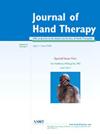The effect of wrist position sense and tactile recognition on manual skills in patients with upper extremity neuropathy
IF 1.8
4区 医学
Q2 ORTHOPEDICS
引用次数: 0
Abstract
Background
Peripheral neuropathy affects fine motor skills in daily life. However, reports on the effects of position sense and tactile recognition on manual dexterity are quite scarce in the literature. The increasing focus on hand rehabilitation has created a need to examine the effects of sensation on manual dexterity.
Purpose
The purpose of this study is to compare the effect of tactile recognition and wrist position sense on manual skills in healthy and neuropathy individuals and to investigate the relationship between them.
Study Design
Cross-sectional, non-randomized comparative clinical study.
Methods
Thirty-seven (50 hands) with median and ulnar nerve neuropathy between the ages of 18 and 65 years and 32 (64 hands) healthy individuals of similar age and gender were included in the study. Wrist position sense was assessed using the K-FORCE Sens electrogoniometer as target angle, 30° wrist flexion and extension, and 10° radial and ulnar deviation. Shape-Texture Identification Test (STI), Purdue Pegboard test (PPT), and Michigan Hand Outcome Questionnaire were applied for tactile recognition, manual dexterity, and hand functions, respectively. The independent-sample t test and Mann-Whitney U test were used for K-FORCE Sens, STI, and PPT to compare groups. Correlation coefficient was used to determine the relationship between variables.
Results
The mean age of individuals with neuropathy and healthy individuals was 45.7 ± 10.3 and 44.5 ± 9.2 years, respectively (p > 0.05). Seventy-three percent of individuals had median neuropathy and 27% had ulnar neuropathy. Totally, 33 dominant and 17 non-dominant hands of patients with neuropathy were affected. When healthy and neuropathic hands were compared, the mean error values in the dominant hand, flexion (4.4 ± 1.4; 6.5 ± 2.9), and radial deviation (2.4 ± 1.0; 3.3 ± 1.7) degrees were higher in the neuropathic hands (p < 0.05). Similar results were also found in the non-dominant hands. However, there was no difference between the mean error values in the extension and ulnar deviation degrees (p > 0.05). STI and PPT subtest results were also lower in the neuropathic hands (p < 0.05). There was a relationship between the mean error values of position sense in the flexion and radial deviation directions in the neuropathic dominant hands and all subtests of the PPT (p < 0.05), while there was a relation in the flexion direction in the non-dominant hand (p < 0.05). No relation was found in the Michigan Hand Outcome Questionnaire test (p > 0.05).
Conclusions
This study has shown that in neuropathy rehabilitation, the assessment of position and tactile sensations should not be ignored in determining participation in manual skills. This article can be used as a starting point for further studies and can be considered as one of the sensory focal points in rehabilitation in the development of manual skills.
腕部位置感和触觉识别对上肢神经病患者操作技能的影响。
背景:周围神经病变影响日常生活中的精细运动技能。然而,关于位置感和触觉识别对手灵巧性影响的文献报道很少。随着人们对手部康复的日益关注,人们需要研究感觉对手灵巧性的影响。目的:本研究的目的是比较触觉识别和手腕位置感对健康人与神经病患者手操作技能的影响,并探讨两者之间的关系。研究设计:横断面、非随机对照临床研究。方法:选取18 ~ 65岁中尺神经病变患者37例(50手)和年龄、性别相近的健康人32例(64手)作为研究对象。使用K-FORCE Sens测角电度仪作为目标角度,腕关节屈伸30°,桡尺偏差10°评估腕关节位置感。采用形状-纹理识别测试(STI)、普渡钉板测试(PPT)和密歇根手结果问卷(Michigan Hand Outcome Questionnaire)分别测试触觉识别、手灵巧度和手功能。K-FORCE Sens、STI和PPT的组间比较采用独立样本t检验和Mann-Whitney U检验。相关系数用于确定变量之间的关系。结果:神经病变组和健康组的平均年龄分别为45.7±10.3岁和44.5±9.2岁(p < 0.05)。73%的人有正中神经病变,27%的人有尺神经病变。神经病变患者的优势手33只,非优势手17只。对比健康手和神经病手,优势手屈曲的平均误差值(4.4±1.4;6.5±2.9),径向偏差(2.4±1.0);3.3±1.7)度高于神经性手(p < 0.05)。神经病变手STI和PPT亚测试结果也较低(p < 0.05)。结论:本研究表明,在神经病变康复中,在确定参与手工技能时,不应忽视体位和触觉的评估。本文可作为进一步研究的起点,并可视为手技能发展中康复的感觉焦点之一。
本文章由计算机程序翻译,如有差异,请以英文原文为准。
求助全文
约1分钟内获得全文
求助全文
来源期刊

Journal of Hand Therapy
医学-外科
CiteScore
3.50
自引率
10.00%
发文量
65
审稿时长
19.2 weeks
期刊介绍:
The Journal of Hand Therapy is designed for hand therapists, occupational and physical therapists, and other hand specialists involved in the rehabilitation of disabling hand problems. The Journal functions as a source of education and information by publishing scientific and clinical articles. Regular features include original reports, clinical reviews, case studies, editorials, and book reviews.
 求助内容:
求助内容: 应助结果提醒方式:
应助结果提醒方式:


